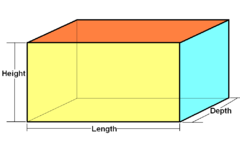- Cuboid
-
For other uses, see Cuboid (disambiguation).
In geometry, a cuboid is a solid figure bounded by six faces, forming a convex polyhedron. There are two competing (but incompatible) definitions of a cuboid in mathematical literature. In the more general definition of a cuboid, the only additional requirement is that these six faces each be a quadrilateral, and that the undirected graph formed by the vertices and edges of the polyhedron should be isomorphic to the graph of a cube.[1] Alternatively, the word “cuboid” is sometimes used to refer to a shape of this type in which each of the faces is a rectangle (and so each pair of adjacent faces meets in a right angle); this more restrictive type of cuboid is also known as a right cuboid, rectangular box, rectangular hexahedron, right rectangular prism, or rectangular parallelepiped.[2]
Contents
General cuboids
By Euler's formula the number of faces ('F'), vertices (V), and edges (E) of any convex polyhedron are related by the formula "F + V - E" = 2 . In the case of a cuboid this gives 6 + 8 - 12 = 2; that is, like a cube, a cuboid has 6 faces, 8 vertices, and 12 edges.
Along with the rectangular cuboids, any parallelepiped is a cuboid of this type, as is a square frustum (the shape formed by truncation of the apex of a square pyramid).
Rectangular cuboid
Rectangular Cuboid 
Type Prism Faces 6 rectangles Edges 12 Vertices 8 Symmetry group D2h, [2,2], (*222) Schläfli symbol {}x{}x{} Coxeter-Dynkin diagram 




Properties convex, zonohedron, isogonal In a rectangular cuboid, all angles are right angles, and opposite faces of a cuboid are equal. It is also a right rectangular prism. The term "rectangular or oblong prism" is ambiguous. Also the term rectangular parallelepiped or orthogonal parallelepiped is used.
The square cuboid, square box, or right square prism (also ambiguously called square prism) is a special case of the cuboid in which at least two faces are squares. The cube is a special case of the square cuboid in which all six faces are squares.
If the dimensions of a cuboid are a, b and c, then its volume is abc and its surface area is 2ab + 2bc + 2ac.
The length of the space diagonal is
Cuboid shapes are often used for boxes, cupboards, rooms, buildings, etc. Cuboids are among those solids that can tessellate 3-dimensional space. The shape is fairly versatile in being able to contain multiple smaller cuboids, e.g. sugar cubes in a box, small boxes in a large box, a cupboard in a room, and rooms in a building.
A cuboid with integer edges as well as integer face diagonals is called an Euler brick, for example with sides 44, 117 and 240. A perfect cuboid is an Euler brick whose space diagonal is also an integer. It is currently unknown whether a perfect cuboid actually exists.
See also
References
External links
- Weisstein, Eric W., "Cuboid" from MathWorld.
- Rectangular prism and cuboid Paper models and pictures
Categories:- Elementary shapes
- Polyhedra
- Prismatoid polyhedra
- Space-filling polyhedra
- Zonohedra
Wikimedia Foundation. 2010.

